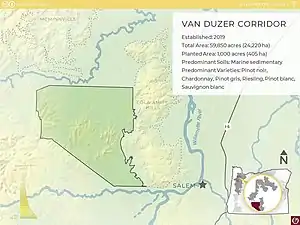Van Duzer Corridor AVA
The Van Duzer Corridor AVA, a sub-appellation of the Willamette Valley AVA located within Polk County, Oregon, in the United States, is an American Viticultural Area approved by the Alcohol and Tobacco Tax and Trade Bureau on December 13, 2018 and effective January 14, 2019.[6][7][8]
| Wine region | |
| Type | American Viticultural Area |
|---|---|
| Year established | 2019[1] |
| Country | United States |
| Part of | Oregon, Willamette Valley AVA |
| Other regions in Oregon, Willamette Valley AVA | Chehalem Mountains AVA, Dundee Hills AVA, McMinnville AVA, Eola-Amity Hills AVA, Ribbon Ridge AVA, Yamhill-Carlton AVA |
| Climate region | Maritine |
| Soil conditions | Marine sediment with basalt over siltstone bedrock[2] |
| Total area | 59,871 acres (24,229 ha)[2] |
| Size of planted vineyards | 1,000 acres (405 ha)[2] |
| No. of vineyards | 18[2][3] |
| Varietals produced | Pinot noir, Pinot gris, Pinot blanc, Sauvignon Blanc, Chardonnay, Riesling, Viognier[4] |
| No. of wineries | 9[3][5] |
The Van Duzer Corridor AVA lies entirely within the established Willamette Valley AVA and covers approximately 59,871 acres. When the petition was submitted there were 17 (now 18[3]) commercially-producing vineyards covering a total of approximately 1,000 acres, as well as 6 wineries (now 9[3]), within the AVA.[2]
The distinguishing features of the Van Duzer Corridor AVA are its topography, climate, and soils.

Topography
Topography is characterized by low elevations and gently rolling hills. The low elevations allow cool breezes to flow relatively unimpeded from the Pacific Ocean, through the Oregon Coast Range, forming a wind corridor gap known as the Van Duzer corridor. The western end of the Van Duzer Corridor wind gap is narrow and squeezed by high elevations to the north and south, leaving little room for viticulture. However, the eastern end of the Van Duzer Corridor wind gap, where the Van Duzer Corridor AVA is located, features the same low elevations and rolling hills as the western portion, with the distinction of having a wider area suitable for vineyards. Within the Van Duzer Corridor AVA, the elevation does not impede the eastward-flowing marine air, allowing higher wind speeds to flow through. In contrast, the surrounding regions all have higher elevations.[2]
Climate
Climate is characterized by consistent high wind speeds and low cumulative growing degree-day (GDD) accumulations. The consistently high winds in the AVA contribute to thicker grape skins, and raise the levels of phenolic compounds in the fruit. In contrast, the wind speeds to the north and south southeast of the AVA are slower. The Van Duzer Corridor has lower GDD accumulations than surrounding regions to the north and southeast, indicating that its temperatures are generally cooler. The cooler temperatures ripen the fruit slowly, creating a longer hang time than for the same grape varietal grown in a region with higher GDD accumulations. The longer hang time contributes to a reduced acidity level.[2]
Soils
Soils are primarily uplifted marine sedimentary loams and silts with alluvial overlay, as well as some uplifted basalt. The soils are typically shallow, well-drained, and have a bedrock of siltstone. The high silt and clay levels in the soils balance the overall pH level of the soil by buffering against a sudden increase or decrease in soil pH. The buffering effect is beneficial to vineyards because it boosts the ability of the soils to maintain a stable pH level. In contrast, the soils immediately outside the northern and western boundaries contain soils from different soil series. Farther north and west, the soils contain higher concentrations of basalt and other volcanic materials. In contrast, east of the Van Duzer Corridor AVA, within the Eola-Amity Hills AVA the soils contain larger amounts of volcanic material than the AVA. Additionally, south of the AVA, the soils contain large concentrations of Ice Age loess, which is not found in the Van Duzer Corridor AVA.[2]
References
- "§9.265 Van Duzer Corridor" (Title 27: Alcohol, Tobacco and Firearms; Part 9— American Viticultural Areas; Subpart C— Approved American Viticultural Areas). Code of Federal Regulations (e-CFR). Retrieved May 20, 2020.
- "Establishment of the Van Duzer Corridor Viticultural Area and Clarification of the Eola-Amity Hills Viticultural Area Boundary Description" (27 CFR 9 83 FR 64276). Alcohol and Tobacco Tax and Trade Bureau. December 14, 2018. pp. 64276–64280.
- "Perseverance Prevails". Oregon Wine Press. February 1, 2019. Retrieved February 7, 2019.
- "Van Duzer Corridor". Oregon Wine Board. Retrieved May 20, 2020.
- "Willamette Valley wine fans will see 'Van Duzer Corridor' on labels". OregonLive. The Oregonian. December 18, 2018.
- Teel, Emily (December 14, 2018). "Van Duzer Corridor named Willamette Valley's newest AVA American Viticultural Area". Statesman Journal. Retrieved January 20, 2019.
- Guzman, Jolene (January 2, 2019). "Van Duzer gets its own AVA". Polk County Itemizer-Observer. Retrieved January 20, 2019.
- Murdoch, Sally (January 15, 2019). "Van Duzer Corridor AVA Approval Shows Location Matters in Oregon". Oregon Wine Industry. Retrieved January 20, 2019.